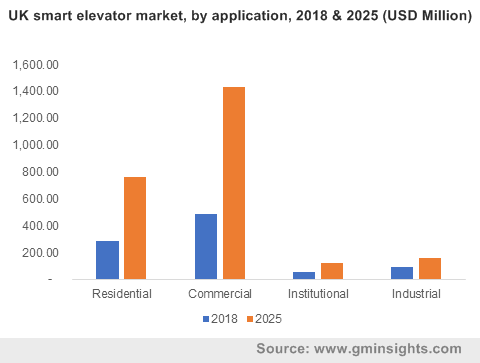Global smart lift market to procure substantial returns from the residential sector by 2025, escalating demand for intelligent building solutions to drive the industry growth
Publisher : Fractovia | Published Date : 2019-05-08Request Sample
Growing investments in constructing intelligent structures with premium comfort & safety would provide a major impetus to smart lift market share over the ensuing years. Smart infrastructure helps operators, owners, and facility managers improve asset reliability and performance, which help better manage and monitor assets, reduce energy costs and carbon footprint.
UK smart elevator market, by application, 2018 & 2025 (USD Million)

Moreover, leveraging excellent technologies such as IoT, Edge Computing, M2M and Intelligent data analytics can also enhance an occupant’s experience and create more attractive and desirable places to work. According to the annual Energy Efficiency Indicator survey, over 75% of companies and organizations in the U.S. are paying more attention to investments in energy efficiency and smart buildings technology with a focus on buildings systems integration and building controls.
In 2018, building controls improvement was the most popular investment avenue in the U.S. with almost 98% of respondents signifying plans to soon implement these measures. Smart lift are a great advantage to smart buildings, as they offer enhanced security, energy efficiency and alerts pertaining to repair schedule. Therefore, increasing investments towards smart buildings will favor the global smart lift market growth over the forecast years.
The construction industry is slated to witness a huge boom owing to the rapidly growing population. Latest data from Timetric’s Construction Intelligence Center projects the construction industry to be one of the fastest growing industries in 2020. The population in the U.S. alone is estimated to surge to over 335 billion, which could lead to a rise in residential housing. Smart lift within a residential setting offer residents with high safety, prevent the entry of unwanted persons along with energy efficiency and advanced maintenance systems. As per a research report by Global Market Insights, Inc., the smart lift market share from the residential application will grow at a CAGR of more than 13% over 2019-2025.
Meanwhile, construction of commercial buildings will also continue to grow considering increased consumer spending and governmental investment in tourism, retail space, and office buildings. Increasing integration of smart technologies will thus drive the adoption graph of smart lift industry.
Lift usually have service lives of more than 20 years; however, their performance can deteriorate over a period of time. When that happens, it is wise for companies or building owners to consider getting their lift modernized. Modernization may not boost the speed of the lift, but it does enhance its performance. This process can also make lift more energy-efficient and lessen energy costs.
Smart lift is witnessing a heavy demand owing to the need for smart modular modernizations like intelligent features, passenger security, and minimum malfunctioning benefits in existing lift systems across the world. Recently, the owner of Raymond James Tower announced it is getting its lift system modernized by German firm ThyssenKrupp for $3 million. The company will be installing a new intelligent system called AGILE, which has the highest level of upgrades available to enhance efficiency, ride comfort and reliability. Increase in similar efforts to enhance existing lift systems will further support the smart lift market growth.
In August 2014, Europe introduced two new standards for designing and manufacturing lifts, that replaced old EN 81-1 and EN 81-2 standards issued in 1998. The standards EN 81-20 and EN 81-50 regulated by the European Committee for Standardization also include a number of requirements that aim to improve passenger safety and convenience. Along with modern and intelligent features, smart lift industry contenders are developing technologies that enable greater safety and comfort in the design and development of their lift. Therefore, the imposition of local and international safety standards will also help accelerate the adoption map of smart lift market in the future.
The ever-increasing demand for modular and energy-efficient lift systems paired with development in the construction sector will primarily boost product demand in the future. Furthermore, a research report by Global Market Insights, Inc., projects the global smart lift market to surpass $25 billion by 2025.